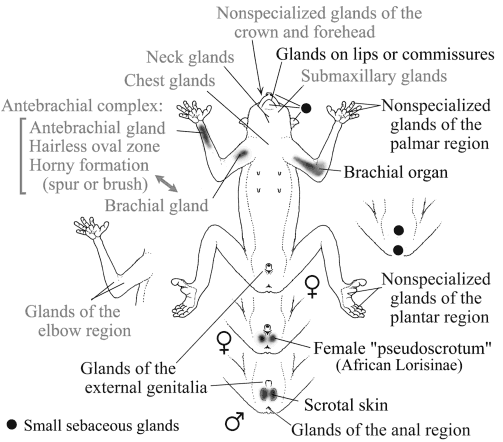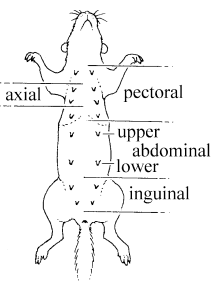Anatomy: skin
glands of
lorises, pottos and other prosimians
Some prosimian skin glands and glandular fields
 Grey text: glands of
Malagasy lemurs;
black
text: glands of lorises and pottos. Based on
Grey text: glands of
Malagasy lemurs;
black
text: glands of lorises and pottos. Based on
Schilling (1979), Alterman (1995), Rasmussen and Nekaris
(1998), Montagna
et al.,
several publications (1959-1966) and data from
Ruhr-University. |
Occurrence
of
scent glands and related structures in prosimians, including the
Malagasy
lemurs. Names of glands occurring in lorisidae are written in
black, glands
only found in Malagasy lemurs in grey. In the Asian lorises, an
optically
inconspicuous, but large brachial organ and other glands,
particularly
in the genital region, occur. The African lorises have got
conspicuous
glandular areas in the genital region instead (scrotal skin,
pseudoscrotum
in female pottos). Based on Schilling (1979), Rasmussen and
Nekaris (1998)
and other sources.

|
Position of
mammae in a
hypothetical
small mammal
(redrawn,
changed,
from Ansell,
1965)
|
|
Number
and
location of mammae: Ansell (1965) recommends routine
recording
of the number of mammae for taxonomic purposes in lower primates
and other
groups. The number may be constant over a whole mammal order or
vary considerably.
Jenkins (1987), quoting several authors, mentions 2-8 mammae in
Loris:
one pectoral pair to two pectoral and two abdominal pairs. At
Ruhr-University,
all lactating Loris fermales had two well visible
(functional) pairs
of pectoral mammae. Only parous females can usually be used for
determination;
some mammae may be non-functional and inconspicuous. Proposition
for a
notation as a mammary formula (Ansell 1965): 1-0-2=6 means 1
pair of pectoral
mammae, no abdominal ones, two inguinal pairs.
References
quoted above:
Ansell,
W. F. H., 1965: Standardisation of field data on mammals.
Zoologica
Africana 1 (1): 97-113.
Jenkins,
P. D., 1987: Catalogue of Primates in the British Museum
(Natural history)
Part IV: Suborder Strepsirrhini. British Museum (Natural
History), London.
Rasmussen,
D. T.; Nekaris, K. A., 1998: Evolutionary history of
lorisiform primates.
Folia Primatol. 69 (Suppl. 1): 250-285.
Schilling,
A., 1979: Olfactory communication in prosimians. Pp.
461-542 in: "The
Study of Prosimian Behavior", Doyle, G. A. and Martin, R. D.
(eds.), Academic
Press, New York.
Some
loris and potto skin gland literature:
Osman
Hill, W. C., 1956: Body odour in lorises. Proc. Zool.
Soc. Lond.
127:
580
Sanderson,
I. T., 1940: The mammals of the north Cameroon forest
area. Transactions
of the Zoological Society of London 14: 623-725
Rasmussen,
D. T.; Nekaris, K. A., 1998: Evolutionary history of
lorisiform primates.
Folia Primatol. 69 (Suppl. 1): 250-285.
Schilling,
A., 1979: Olfactory communication in prosimians. Pp.
461-542 in: "The
Study of Prosimian Behavior", Doyle, G. A. and Martin, R. D.
(eds.), Academic
Press, New York.
Manley, G. H., 1976:
Functions of
the external genital glands of Perodicticus and Arctocebus.
Pp. 313-329 in: Prosimian Behaviour, Martin, R.D.; Doyle, G. A.;
Walker,
A. C. (eds.), Duckworth, London
Alterman, L., 1995: Toxins
and toothcombs:
potential allospecific chemical defense in Nycticebus and
Perodicticus.
Pp. 413-424 in: Creatures of the Dark, Alterman, L.; Doyle, G.;
Izard,
M. K. (eds.), Plenum Press, New York.
Alterman, L.; Hale, M. E.,
1991:
Comparison of toxins from brachial gland exudates from Nycticebus
coucang
and N. pygmaeus. American Journal of Physical
Anthropology, Sup.
12: 43.
Montagna, W.; Ellis, R. A.,
1960:
The skin of primates II: the skin of the slender loris (Loris
tardigradus).
Am. J. Phys. Anthropol. 18: 19-43.
Montagna, W.; Yasuda, K.; Ellis,
R.
A., 1961: The skin of primates III: the skin of the slow
loris (Nycticebus
coucang). Am. J. Phys. Anthropol. 19: 1-21.
Montagna, W.; Ellis, R. A.,
1959:
The skin of primates I: the skin of the potto (Perodicticus
potto).
Am. J. Phys. Anthropol. 17: 137-162.
Montagna, W.; Yun, J. S.,
1962:
The skin of primates XIV: further observations of Perodicticus
potto.
Am. J. Phys. Anthropol. 20: 441-449.
Montagna, W.; Machida, H.;
Perkins,
E. M., 1966: The skin of primates 33: the skin of the
angwantibo (Arctocebus
calabarensis). Am. J. Phys. Anthropol. 25: 277-290.
Privacy policy / Datenschutz
Back to the top of this page
|
Loris
and related species: health
|
Last
amendment: 24 March
2002
|


